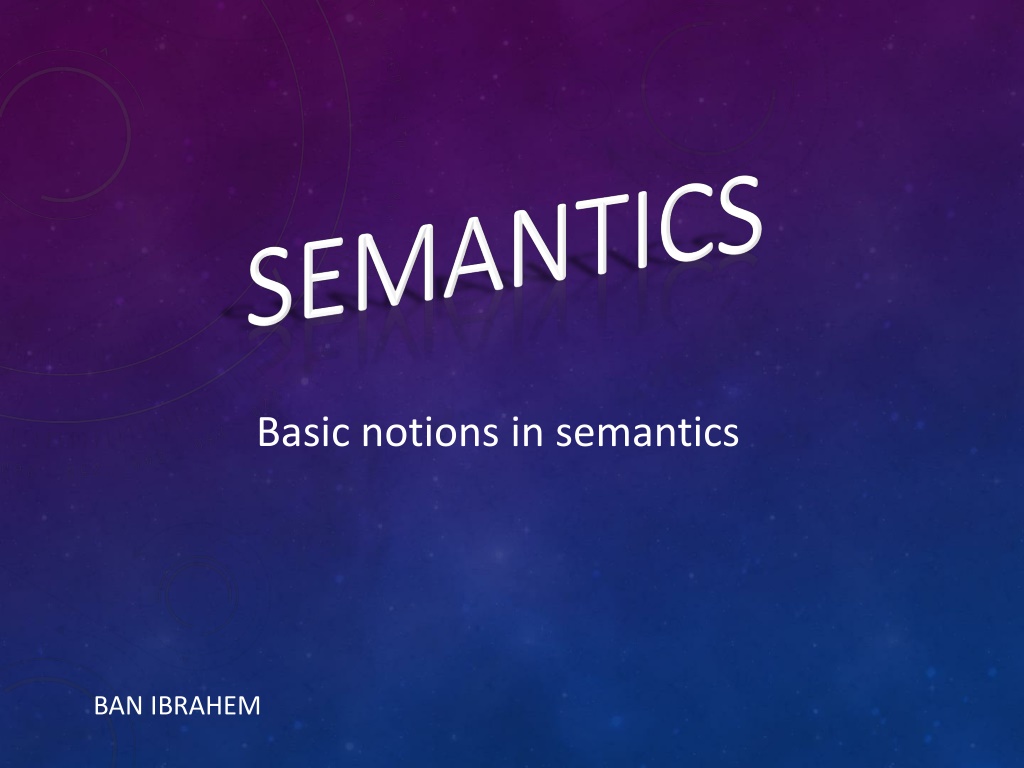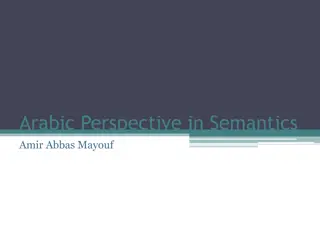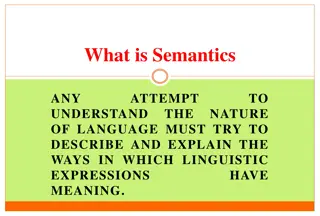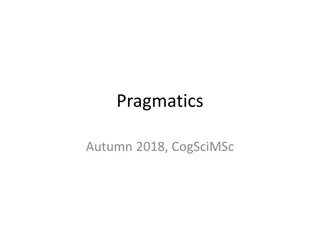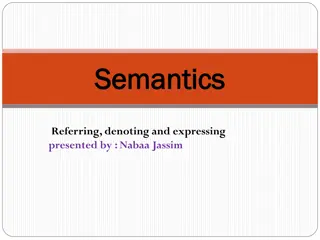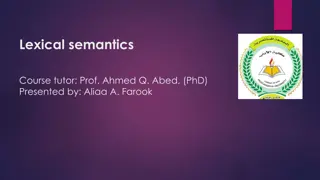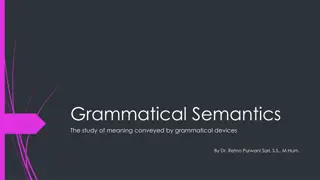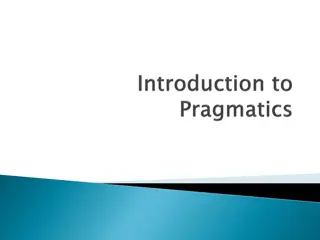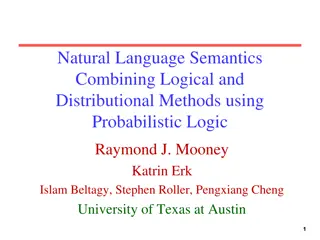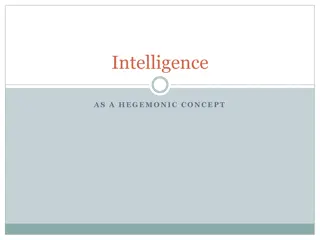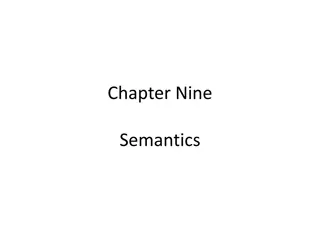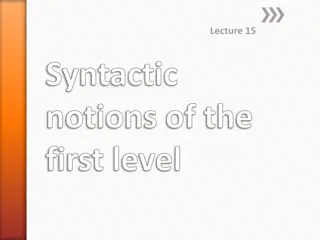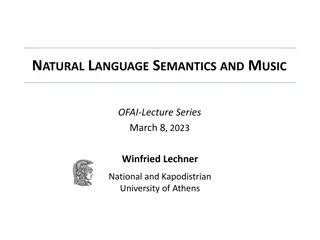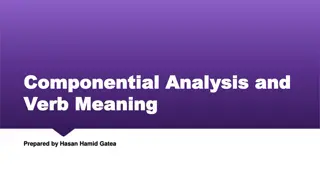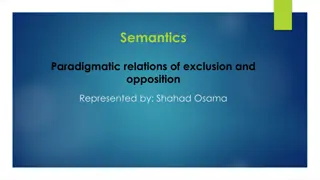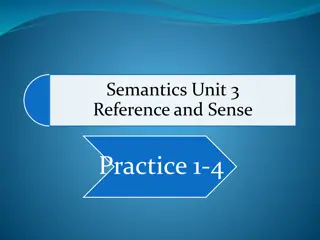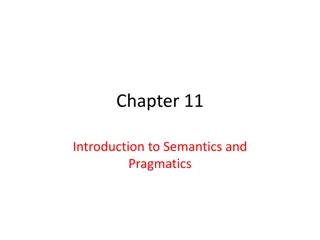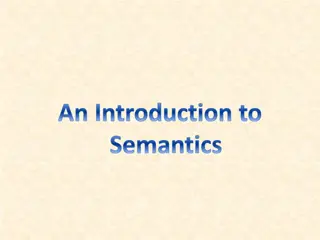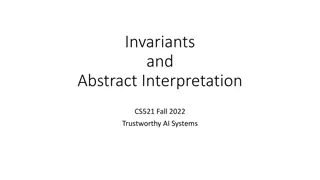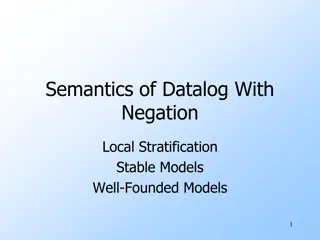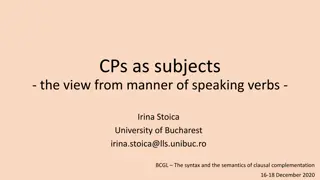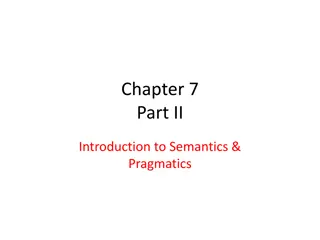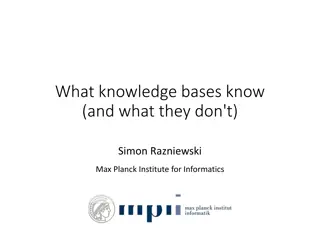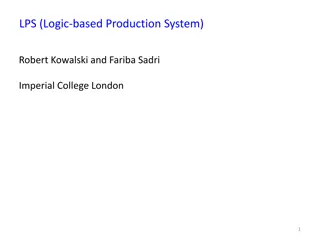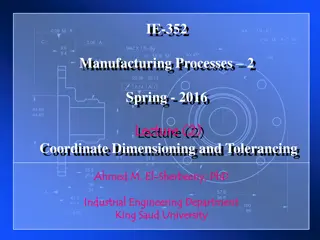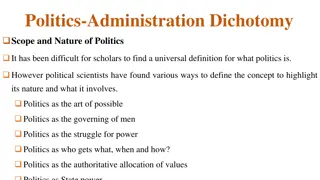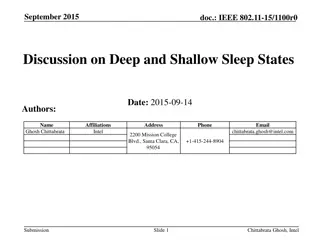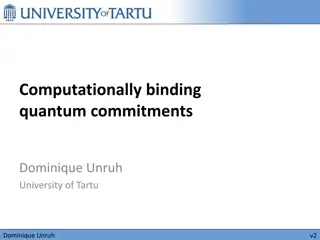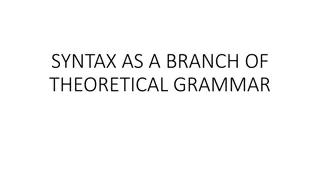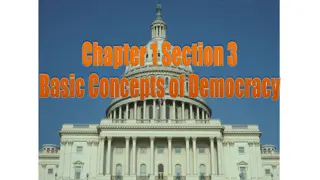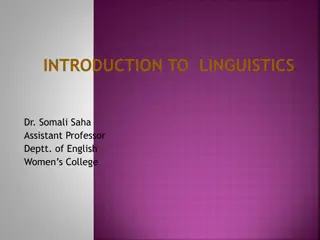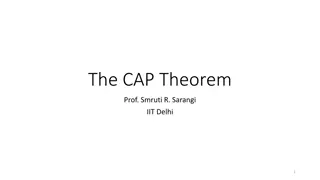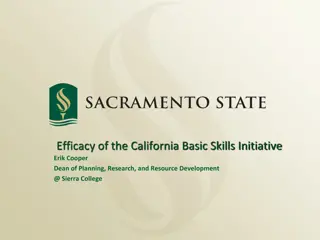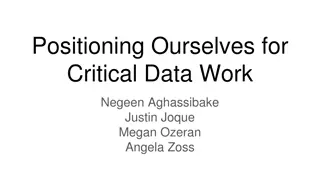Understanding Semantics: Basic Notions and Definitions
Semantics is a serious academic discipline focusing on the meaning of language. It delves into denotation, connotation, and the semiotic triangle, aiming to provide a clear understanding of how meaning operates in language use. Definitions from notable linguists like John Lyons and insights into semantic implications are discussed.
Download Presentation

Please find below an Image/Link to download the presentation.
The content on the website is provided AS IS for your information and personal use only. It may not be sold, licensed, or shared on other websites without obtaining consent from the author. Download presentation by click this link. If you encounter any issues during the download, it is possible that the publisher has removed the file from their server.
E N D
Presentation Transcript
Basic notions in semantics BAN IBRAHEM
TABLE OF CONTENTS Semantic definition Semantics definitions according to : - John Lyons (1995) - John said (2009) - Leech (1981) Semantic Notions: -Denotation & Connotation - Semiotics: The semiotic triangle: Language ,mind, world and meaning
Semantics Is a serious academic discipline like any other branch of theoretical knowledge . It aims at providing a clear understanding of how language operates at the level of meaning .It is ,in another words , a serious and systematic study of how meaning is structured , expressed and understood in the use of language . *Thakur, D. (1999). Linguistics Simplified Semantics. Bharati Bhawan .
SEMANTIC DEFINITIONS ACCORDING TO : 1- John Lyons (1995): Semantics is traditionally defined as the study of meaning ;and this is the definition which we shall initially adopt .But do all kinds of meaning fall within the scope of semantics ,or only some ?What is meant by Meaning in this context .The noun meaning; and the verb mean ,from which it is derived , are used , like many other English words , in a wide range of contexts and in several distinguishable senses .For example , to take the case of the verb :If one says :
1- Marry means well One implies that marry is well-intentioned , that she intends no harm. This implication of intention would normally be lacking, however, in an utterance such as 2- That red flag means danger In saying this , one would normally be implying that the flag had plans to endanger anyone ; one would be pointing out that it is being used (in accordance with a previously established convention ) to indicate that there is danger in the surrounding environment , such as a crevasse on a snowy hillside or the imminent use of explosive in a nearby quarry . Similar to the red flag use of the verb mean , in one respect at least ,it is used in .
3- Smoke means fire In both (2) and (3) one thing is said to be a sign of something else :from the presence of the sign , a red flag or smoke , anyone with the requisite knowledge can infer the existence of what it signifies, danger or fire , as the case maybe . But there is also an important difference between (2) and (3). Whereas smoke is a natural sign of fire , causally connected with what is signifies , the red flag is a conventional sign of danger :it is a culturally established symbol .
These distinctions between the intention and the non- intention , on the one hand , and between what is natural and what is conventional , or symbolic , on the other , have long played a central part in the theoretical investigation of meaning and continue to do so .* *Lyons, J. (1995).Linguistic Semantics: An Introduction .Cambridge :CUP.
2- John said (2009): Semantics is the study of meaning communicated through language. One of the insights of modern linguistics is that speakers of a language have different types of linguistic knowledge , including how to pronounce words ,how to construct sentences, and about the meaning of individual words and sentences .To reflect this ,linguistics description has different levels of analysis . so Phonology is the study of what sounds a language has and how these sounds combine to form words; Syntax is the study of how words can be combine to form sentences ; and Semantics is the study of the meanings of words and sentences .As well as semantics is a very broad field of inquiry , and we find scholars writing on very different topics and using quite different methods, though sharing the general aim of describing semantic knowledge ,As a result semantics is the most diverse field with linguistics. In addition , semantics have to at least a nodding acquaintance with other disciplines.* *Saeed,J.(2009). Semantics : An Introduction,(3ed ed.).Oxford :Blackwell.
3- Leech(1981)/ Semantics (as the study of meaning ) is the central to the study of communication; and as communication becomes more and more a crucial factor in social organization , the need to understand it becomes more and more pressing .Semantics is also at the Centre of the study of the human mind thought processes, cognition , conceptualization all these are intricately bound up with the way in which we classify and convey our experience of the world through language . Leech studies semantics through the seven types of meaning:
1- DENOTATIVE ( DENOTATIVE ( CONCEPTUAL ) CONCEPTUAL ) MEANING MEANING : Conceptual meaning is also called logical or cognitive meaning. It is the basic propositional meaning which corresponds to the primary dictionary definition . It is the essential or core meaning . Ex// /P/ can be describe as Voiceless + bilabial+ plosive Boy = + human +male + adult
2 2- - CONNOTATIVE MEANING: CONNOTATIVE MEANING: Connotative meaning is the communicative value of an expression over and above its purely conceptual content. It is something that goes beyond mere referent of a word and hints at its attributes in the real world Ex// the conceptual content of woman is +human +female + adult + but the psychosocial connotation could be gregarious , having maternal instinct . The boundary between conceptual and connotative seems to be analogous , connotative meaning is regarded as incidental comparative unstable in determinant , open ended , variable according to age , culture and individual , whereas conceptual meaning is not like that . It can be codified in terms of limited symbols .
3 3- - SOCIAL MEANING : SOCIAL MEANING : 1- I ain t done nothing This example tells us about the speaker and that he is probably a black American , underprivileged and uneducated. 2- come on yaar. Be a sport. Don't be Lallu The social meaning shows that the speakers are a close friend from India .
4 4- - AFFECTIVE OR EMOTIONAL MEANING : AFFECTIVE OR EMOTIONAL MEANING : It refers to emotive association or effects of words evoked in the reader , listener . It is what is conveyed about the personal feeling or attitude towards the listener. Ex// home for a sailor/soldier and mother for a motherless child . For Leech affective meaning refers to what is convey about the feeling and attitude of the speak through use of language (attitude to listener as well as attitude to what he is saying )
5 5- - REFLECTED MEANING REFLECTED MEANING : Reflected meaning arises when a word has more than one conceptual meaning or multiple conceptual meaning . Ex// Daffodils the could not but be gay In such jocund company The word gay was frequently used in the time of William Wordsworth but the word now is used for homosexuality .
6 6- - COLLECTIVE MEANING COLLECTIVE MEANING : Collective meaning is the meaning which a word acquires in the company of certain words. Words collocate or co-occur with certain words only Ex// Big business not large or great
7 7- - THEMATIC MEANING THEMATIC MEANING : It refers to what is communicated by the way in which a speaker or a writer organizes the message in terms of ordering focus and emphasis. Thus active is different from passive though its conceptual meaning is the same ,and the way we order our message also convey what is important and what is not . Ex/ * Mrs. Smith donated the first prize *The first prize was donated by Mrs. Smith In the first sentence who gave away the prize is more important ,but in the second sentence what did Mrs. smith gave is important .Thus the change of the focuse change the meaning also .
SEMANTIC NOTIONS SEMANTIC NOTIONS : 1- Denotation / The denotation of a word is the object or the objects that it refers to in the world outside language .The denotation of the word elephants ,for example ,is the actual elephants all over the world .The denotation of the word whale is the whales found in seas all over the globe .The denotation of a word is, thus , the same thing as the referent of that word . But just as the meaning of reference needs to be understood in the relation to the meaning of sense ,the meaning of denotation needs to be understood in relation to the meaning of connotation .
2- Connotation / the connotation of a word is the incidental meaning that we associate with a word from time to time .Putative qualities (i.e. qualities which are often supposed to be there) expressed by adjective like frail , sentimental , tender likely to shed tears , kind and compassionate can ,for example, be mentioned as some of the connotation of the word woman . It may be pointed out here that through the denotation of a word usually remains more or less the same , the connotation of a word changes with the passage of time .In many cases it changes from one culture to another and in some cases it changes from one individual to another .Thus, the connotation of a word is unstable and, compared to its denotation ,it is peripheral to its meaning . *Thakur, D. (1999). Linguistics Simplified Semantics. Bharati Bhawan .
3- Semiotic /(semiotic triangle) Thought (Reference) Symbol Referent
At the top of the triangle is what Ogden and Richards called thought . This reflects the fact that language comes from human beings, and is therefore ultimately a product of processes in the mind or brain. But thought can be a misleading label for these processes, for two reasons: . First, these mental processes need not be conscious. Even though we sometimes do consciously think about what we are going to say, our speech is more often spontaneous, emerging without our being aware of any preliminary stage of mental preparation. Since it is the brain that produces language, we know that some such preliminary stage must have taken place, but since this stage is so often unconscious, the label thought is not the most appropriate
The second reason that thought is an unfortunate label for the mental processes at the origin of speech is that it excludes the non-rational, emotional side of our inner life. The processes leading to speech should not be limited to what we would class simply as thinking , but extend to include our emotions and volition as well. This is most obviously true with exclamations: exclamations of pain, surprise or happiness often do not reflect anything we would describe as a thought , but rather reflect a particular feeling. The same is true for many other types of words, like diminutives, which may correspond to feelings of (roughly) affection; and imperatives, which may be accompanied by feelings of control, superiority, pride, etc. Evaluative words more generally, expressing the speaker s emotional attitude, often force us to recognize a strong emotional component. Thus, marvelous , wonderful , fantastic and good ; and appalling , terrible , frightful and bad and their synonyms express more than the fact that the speaker approves or disapproves of whatever is being referred to: crucially, these adjectives are often associated with particular positive or negative feelings in the speaker. *NICK, R. (2010). Introducing Semantics. New York: United States of America by Cambridge University Press.
Knowledge requires curiosity Don t hesitate to ask
